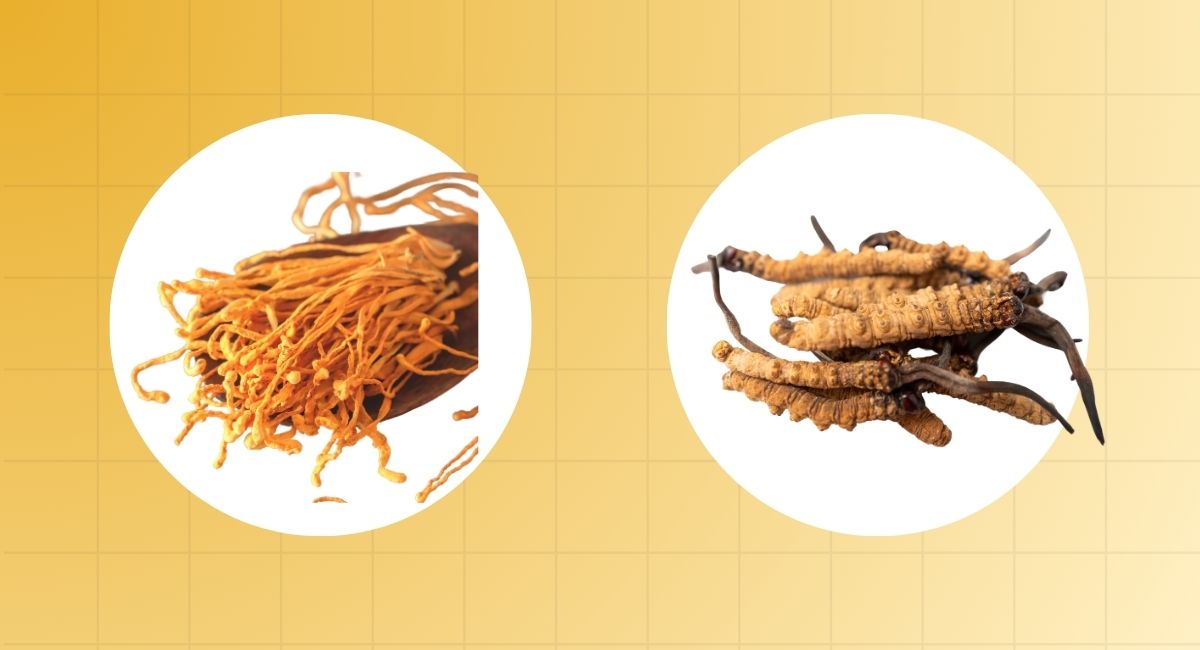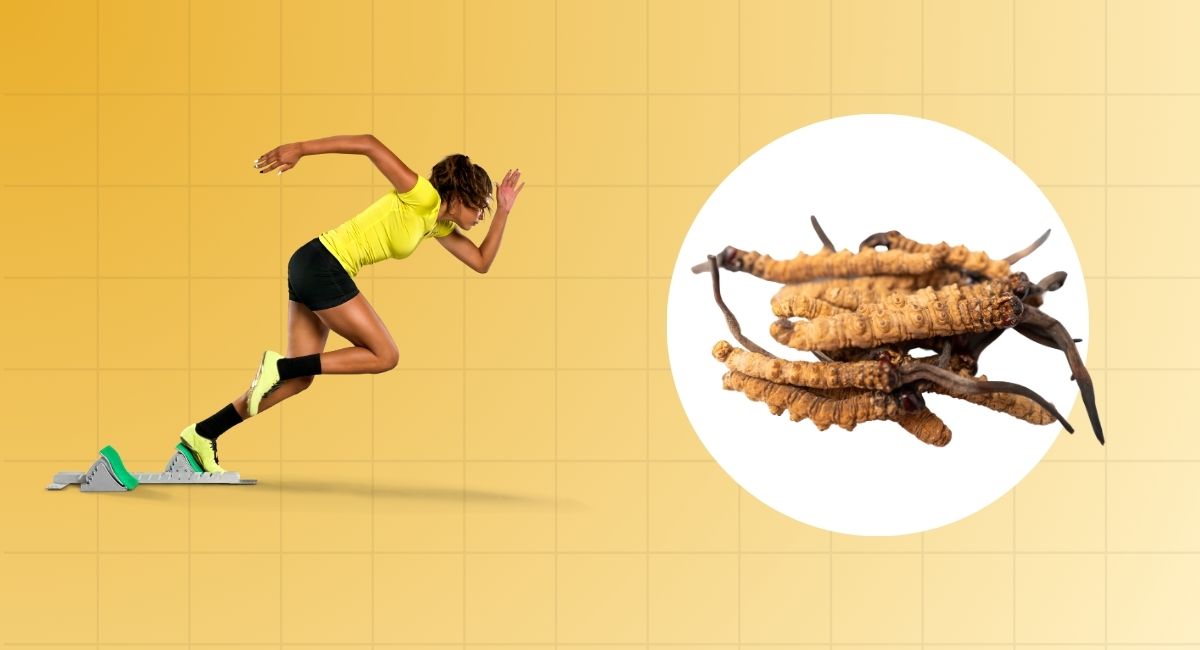A mushroom or toadstool is a fungus's soft, spore-producing part that grows above the ground, on soil, or on whatever it feeds on.
There are over 10,000 species of mushrooms that have different textures and flavors.
Among them, Cordyceps stands out as it holds the title of "Gold of Mushrooms” for its exceptional properties.
It grows in extreme altitudes on six continents (except Antarctica) and has been used in Asia for centuries to treat asthma, erectile dysfunction, and as a natural aphrodisiac.
But out of around 700 known species of Cordyceps, two stand out for health research: Cordyceps Sinensis and Cordyceps Militaris.
What are these two cordyceps? What’s their difference? What benefits can you get from these two popular types?
We’ll discuss it all but first, let’s get the basics right.
What Are Cordyceps Mushrooms?
Cordyceps, a fungus with the Latin name Ophiocordyceps Sinensis, has been used in traditional medicine for generations across various cultures.
In the wild, it looks like thin, yellow-brown fingers but resembles dried autumn leaves when prepared for medicinal use.
Cordyceps has a long history, dating back to 620 AD when it was thought to be a magical creature that could transform from an animal to a plant.
It gained prominence in traditional Chinese medicine in 1694 when it was mentioned in the medical text Ben Cao Bei Yao, solidifying its status as one of the most important medicinal herbs.
For centuries, traditional Chinese medicine has used Cordyceps to help with fatigue, illness, kidney problems, and low sex drive.
Recently, cordyceps have gained a modern following thanks to their impressive medicinal properties.
Did you know that the Chinese Olympic team used Cordyceps during their training for the 1993 Beijing Olympics?
What makes Cordyceps special?
Cordyceps has one of the most unique and fascinating life cycles among medicinal mushrooms. Unlike most mushrooms that grow on decaying matter, Cordyceps uses live moth larvae as its host.
In summer, Cordyceps spores infect the larvae underground, feeding on them throughout winter. By spring, the fungus pushes the larvae to the surface, where they die, and a stalk-like fungus grows from their bodies.
The unique process earned it the Tibetan name "yartsa gunbu," meaning "winter worm, summer grass."
In English, Cordyceps Sinensis is often called "caterpillar fungus."
About Cordyceps Sinensis (Wild Caterpillar Fungus)
Cordyceps Sinensis has the longest history in Chinese medicine. In the wild, it infects an insect host and grows out of its head using the larva as food.
Foragers in the Himalayas would collect the fused larva and fungus and consume them together.
Traditional healers used Cordyceps Sinensis to treat ailments like tuberculosis, erectile dysfunction, bronchitis, and chronic pain. It was also commonly mixed with milk and taken as a natural aphrodisiac.
Cordyceps Sinensis is extremely rare and costly, with prices reaching up to $20,000 per kilogram. But the intrinsic qualities are unparalleled to any other mushroom species on earth.
Benefits of Cordyceps Sinensis
There are numerous benefits of Cordyceps Sinensis dating back to ancient Chinese history. We have listed a few for which research is available, and many of the benefits are still to be rediscovered through scientific research.
Improve exercise intensity
Cordyceps Sinensis may boost the production of adenosine triphosphate (ATP), a molecule critical for supplying energy to muscles. It can enhance oxygen utilization, particularly during physical activity.
A 2024 study tested this by giving 14 young adults either 1 gram of Cordyceps Sinensis or a placebo before a high-intensity workout. Results showed that those who took Cordyceps experienced reduced muscle damage compared to the placebo group.
Slow down cancer
Cordyceps Sinensis has shown promise in inhibiting tumor growth in various cancer cell types, including colon, skin, and liver cancers, as demonstrated in laboratory studies.
Animal research further indicates potential anti-tumor effects against leukemia and lung cancer. However, these findings are primarily from test-tube and animal studies.
Better heart health
Cordyceps Sinensis may support heart health through various mechanisms. A 2019 study in mice compared the effects of Cordyceps to a placebo and found it helped prevent heart enlargement by reducing oxidative stress.
It is significant, as oxidative stress in the heart can lead to conditions like cardiac hypertrophy.
The heart-protective effect may be due to the presence of adenosine, a compound naturally found in Cordyceps that is thought to benefit the heart.
Also, Cordyceps Sinensis may help manage blood fat levels, such as triglycerides, which are linked to a lower risk of heart disease when kept in check.
Control diabetes and cholesterol
According to a 2018 study on mice with diabetes, Cordyceps Sinensis may help manage blood sugar and cholesterol levels.
The research showed that Cordyceps could lower both blood sugar and lipid levels, indicating its potential in addressing conditions like diabetes and atherosclerosis, a condition where fat and cholesterol build up in the arteries.
Reduce aging
Cordyceps is rich in polyphenols, which act as antioxidants and help combat cell damage by neutralizing free radicals. It reduces their impact on aging and disease.
A 2024 study tested Cordyceps extract in both test tubes and a clinical trial involving 40 participants. The results suggested that Cordyceps has adaptogenic properties, aiding the body in managing stress.
It also showed antioxidant effects and boosted collagen production in the skin, supporting healthier skin.
Now let’s discuss the other contender in our discussion.
About Cordyceps Militaris
Cordyceps Militaris is a lab-grown substitute for Cordyceps Sinensis. Traditional Chinese Medicine has used Cordyceps Sinensis for centuries, but because of its popularity, the demand couldn’t be matched.
Also, cultivating Cordyceps Sinensis proved difficult, so scientists searched for an alternative with a similar chemical profile and health benefits but easier to grow.
Their solution was Cordyceps Militaris, a close relative of Cordyceps Sinensis. Like its cousin, it’s a parasite in the wild, growing on insects or fungi.
However, it can thrive on substrates like rice in controlled environments which makes it much easier to cultivate.
It solved the problems of overharvesting and supply shortages. However, it’s worth noting that Cordyceps Militaris became popular as a substitute for Cordyceps Sinensis and doesn’t have the same long history of traditional use.
Many producers choose it for its ease and cost-efficiency, rather than its intrinsic qualities.
Benefits of Cordyceps Militaris
You now know that Cordyceps Militaris is not that effective on your health compared to Cordyceps Sinensis but still it has some benefits that we can discuss:
Inflammation-fighting properties
While short-term inflammation plays a key role in healing, chronic inflammation can contribute to various diseases. Research from 2020 found that Cordyceps Militaris may help suppress proteins that promote inflammation when human cells are exposed to it.
It has led researchers to explore Cordyceps as a potential anti-inflammatory supplement.
For example, a 2022 animal study showed that it reduced inflammation associated with arthritis, with similar effects observed in studies on asthma and allergic rhinitis.
Immune system
One of the main benefits of Cordyceps Militaris today is their ability to support natural immunity.
It is because of beta-glucans, a type of polysaccharide found in these mushrooms. Research shows that beta-glucans can trigger an immune response that helps your body defend itself against germs.
Antiviral effects
Cordyceps Militaris is known for its powerful antiviral properties, thanks to its high levels of cordycepin which is a compound that can interfere with viral replication.
Research published in the Journal of Agricultural and Food Chemistry found that Cordyceps Militaris contains up to 90 times more cordycepin than wild Cordyceps Sinensis which makes it a highly effective natural option for supporting the body’s defense against viral infections.
Now let’s wrap up by understanding the general difference between the two species.
Cordyceps Militaris Vs. Cordyceps Sinensis
You might be wondering why two different fungi have such similar names. It comes down to the taxonomic system developed by Carl Linnaeus, which organizes organisms based on their relationships.
Based on nomenclature, Cordyceps Militaris and Cordyceps Sinensis are closely related, differing only at the family level.
In addition to Militaris and Sinensis, there are many other Cordyceps species, such as Cordyceps Sobolifera and Cordyceps Cicadae.
While they are less known, they are being studied for their potential medicinal properties. There are also other species with yet-to-be-discovered benefits.
Both Militaris and Sinensis belong to the phylum Ascomycota, which includes fungi that produce spores in tiny sacs called asci.
Now let’s discuss the Cordyceps Militaris Vs Cordyceps Sinensis difference based on other important factors.
Price and Availability
Cordyceps Sinensis: This species is rare and primarily found in the high-altitude regions of the Himalayas. Its scarcity and labor-intensive harvesting process make it extremely expensive, with prices reaching up to $20,000 per kilogram.
Cordyceps Militaris: Unlike Sinensis, Militaris can be cultivated on substrates like rice, making it more accessible and affordable. This ease of cultivation ensures a steady supply of supplements.
Active Compounds and Benefits
Cordyceps Sinensis: Traditionally used in Chinese medicine, it is believed to enhance stamina, libido, and overall vitality. These mushrooms may also help in improving heart health, fighting cancer, and controlling diabetes and cholesterol.
Cordyceps Militaris: Research indicates that Militaris contains higher levels of cordycepin, a compound associated with anti-inflammatory and anti-tumor properties. It also helps in enhancing energy and immune function.
Traditional Use and History
Cordyceps Sinensis: With a long-standing role in traditional Chinese medicine, Sinensis has been used for centuries to treat various ailments.
Cordyceps Militaris: While it doesn't share the same extensive historical use, its similar properties have led to its adoption as a viable alternative in modern supplements.
Now that you know the difference between the two species, you might want to experience Cordyceps Sinensis which is natural and used in ancient Chinese medicine compared to a lab-grown variety.
Where To Buy Pure And High-Quality Cordyceps Sinensis?
At Pahadi Amrut, we honor ancient cultures and the wisdom of traditional remedies. We are committed to offering authentic, rare, and raw products in their purest form.
That’s why we focus solely on providing Cordyceps Sinensis, the natural variety treasured for centuries in traditional medicine, rather than the lab-grown Cordyceps Militaris.
Our philosophy is simple: we believe in delivering nature’s gifts without altering or processing them.
If you’re interested in experiencing the unmatched benefits of Cordyceps Sinensis, feel free to reach out to us.
You can request a price quote, and our team will be happy to assist you.




1 comment
Domsing Cheda
If you kindly provide me cordyceps for my personal used
If you kindly provide me cordyceps for my personal used